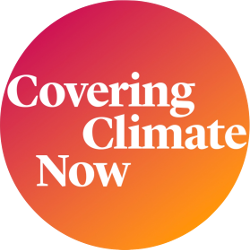An endangered African penguin emerges from the water at Seaforth Beach, South Africa, Nov. 3, 2020. (CNS/Reuters/Sumaya Hisham)
Editor's note: This story originally appeared at Mongabay and is republished here as part of Covering Climate Now, a global journalism collaboration strengthening coverage of the climate story.

Over the past 20 years, the concept of "tipping points" has become more familiar to the public. Tipping points are critical thresholds at which small changes can lead to dramatic shifts in the state of the entire system.
From a climate standpoint, the melting of Arctic sea ice is a simple example. As sea ice melts, less sunlight is reflected into space and more heat is absorbed by the ocean, further hindering the formation of sea ice and thereby leading to more warming. The positive feedback loop is leading toward ice-free summers in the Arctic, which will have dramatic implications for the Arctic ecosystem and knock-on effects for ocean circulation and weather patterns. The effects are already being observed, with Arctic sea ice extent trending sharply downward since the 1970s.

Climate scientist Tim Lenton, director of the Global Systems Institute at Britain's University of Exeter (Mongabay)
Awareness of climate tipping points has grown in policy circles in recent years in no small part thanks to the work of climate scientist Tim Lenton, who serves as the director of the Global Systems Institute at Britain's University of Exeter.
In 2008 Lenton was the lead author of an influential Proceedings of the National Academy of Sciences (PNAS) paper that identified nine tipping points and ranked them by their near-term likelihood of occurring. These included: Arctic Sea-Ice; the Greenland Ice Sheet; the West Antarctic Ice Sheet; the Atlantic Thermohaline Circulation; the El Niño–Southern Oscillation (ENSO); the Indian Summer Monsoon; the Sahara/Sahel and West African Monsoon; the Amazon Rainforest; and the Boreal Forest. Lenton and his colleagues have since added tropical coral reefs and the East Antarctic Ice Sheet to the list.
When Lenton published the PNAS paper, some aspects of the predictions were still theoretical, but since then, the evidence for some tipping points has strengthened as the rate of disruption has increased and our ability to observe change has improved.

Map of potential policy-relevant tipping elements in the climate system in Tim Lenton et. al. 2008 original paper. These have since been updated to include coral reefs and the East Antarctic Ice Sheet. (Montabay/Tim Lenton et. al.)
"Some of the tipping elements are changing more rapidly than others," Lenton told Mongabay during a December 2020 interview. "The most concerning include the West Antarctic Ice Sheet — part of it looks to be in irreversible retreat — and the Amazon rainforest — where droughts and changing fire regimes are accelerating forest loss, alongside renewed human pressures."
The evidence base of cascading effects between tipping points has also expanded.
"A decade or so ago we identified this as a theoretical possibility with some idea of what the causal interactions could be," he said. "Now we have more direct evidence of causal interactions, like the role of Arctic sea-ice retreat and resultant warming in permafrost thawing and accelerating Greenland ice sheet melt."
Lenton says the the rate at which we appear to be approaching several tipping points is now ringing alarm bells, but "most of our current generation of politicians are just not up to this leadership task."
"Younger generations are looking at them with dismay and rightly rebelling."
The pandemic however may have caused a shock to the system that could trigger what he calls "positive social tipping points" that "can accelerate the transformative change we need" provided we're able to empower the right leaders.
"The COVID-19 pandemic has taught us that when a threat is truly urgent we can act decisively and put aside neoliberal economics in favor of saving lives. But politicians immediately started talking about 'building back better' rather than taking the opportunity to 'build forward better' — i.e. to chart a new economic and ecological path."
Lenton spoke about these issues and more in a conversation with Mongabay Founder Rhett A. Butler.
Mongabay: How did you become interested in the idea of tipping points?
Tim Lenton: I started out studying Gaia and identifying how aspects of the Earth system self-regulate. In Jim Lovelock's models like Daisyworld and in Earth history there are key moments where self-regulation breaks down and strong reinforcing feedbacks take over to propel abrupt change. Although I didn't call them "tipping points" at the time, that's what they are. When Malcolm Gladwell published The Tipping Point, it seemed natural to adopt that language.
How does the concept of tipping points intersect with the idea of planetary boundaries?
Where undesirable tipping points exist it makes it easier to set a "safe" planetary boundary to avoid them. But not all planetary boundary variables have tipping points. Climate and ocean deoxygenation driven by nutrient inputs clearly do.
Hence I used those tipping points to help inform the original setting of planetary boundaries for climate and nutrient inputs. But other planetary boundaries lack an obvious tipping point so have to be set in a different way.
Advertisement
In your highly-cited 2008 PNAS paper, you and your co-authors identified several tipping points. Has that list changed since then? And have some of those tipping points progressed more rapidly than others?
The list has changed somewhat over time, but not as much as thought it might. I put question marks on some of the original list and map to show I was less sure about them. Tropical coral reefs are now on the list, as is part of the East Antarctic Ice Sheet draining the Wilkes Basin.
Some of the tipping elements are changing more rapidly than others. The most concerning include the West Antarctic Ice Sheet — part of it looks to be in irreversible retreat — and the Amazon rainforest — where droughts and changing fire regimes are accelerating forest loss, alongside renewed human pressures.
You've warned about the risk of one tipping point potentially triggering another tipping point as a sort of cascading domino effect. How has the science around that idea improved over the past decade?
A decade or so ago we identified this as a theoretical possibility with some idea of what the causal interactions could be. Now we have more direct evidence of causal interactions, like the role of Arctic sea-ice retreat and resultant warming in permafrost thawing and accelerating Greenland ice sheet melt. Also the contribution of Greenland melt water to disrupting North Atlantic deep water formation and the Atlantic overturning circulation. Plus we now have some models for how the interactions could play out.
Here in the American West we're reaching the end of what was a catastrophic fire season and we're told that we should expect this to be the new normal going forward. Have you identified any tipping point when it comes to forest fire dynamics here?
Fires generate their own reinforcing feedbacks — drying the fuel load, creating local convection and winds, and even thunderstorms — and such self-amplifying feedbacks are the vital ingredient for creating tipping point dynamics.
Fire regimes in the wet tropics can pass a tipping point from localized fires to much larger "mega fires" — a bit like a phase transition in physics. Such mega-fires now seem to be happening in the American West, Australia and even the Arctic. So there looks to be a localized fire tipping point, and some signs that it is being passed at similar times across large areas — making for a bigger tipping point.
rainforest near Porto Velho, Brazil, Aug. 16, 2020. (CNS/Reuters/Ueslei Marcelino)
From the appearance of dry forest species like the maned wolf and the rise in drought and fire in the Amazon in recent years, there seems to be increased evidence of significant changes occurring in Earth's largest rainforest. How will we know when we're actually near the tipping point?
One way to find out is to look for the characteristic early warning signals of approaching a tipping point — the forest 'slowing down' in its recovery from perturbations (like the recent drought years). We've being analyzing the data and we think we've picked up this slowing down signal of the Amazon rainforest losing resilience across large areas. To pinpoint whether we are close to a tipping point one can also look at the least resilient parts of the forest (e.g. in the Southeast) and see if they are locally being tipped into an alternative stable state by droughts or fires — and how easily that tipping happens.
In 2018, you wrote a perspective updating the Gaia theory and proposing that it serve as a "framework for fostering global sustainability." Can you elaborate on this?
Whether you agree or not with the original Gaia theory, it is obvious that we are becoming collectively self-aware of the bad consequences of our actions on our own life-support system. My proposal with Bruno Latour is that we could in principle add a bit of self-awareness to the Earth's self-regulation. At the very least we could sense where things are going wrong better (through satellites etc) and correct our mistakes faster. We could also use the prior Gaia to provide a template for designing a more flourishing sustainable future — including sustainable energy, material recycling, and horizontal information exchange, supporting a rapid learning process.

Glaciers and icebergs in Antarctica (Mongabay)
Arguably, there has been very little progress in curbing carbon emissions since your 2008 tipping points paper despite a growing body of scientific evidence on the need to take action. What do you think it will take to catalyze an appropriate sense of urgency among the general public and politicians? And has the COVID-19 pandemic made any difference on this front?
I think there is an appropriate sense of urgency among many in the general public who protested together and forced government declarations of a "climate emergency." The problem is we need urgent action and most of our current generation of politicians are just not up to this leadership task. Younger generations are looking at them with dismay and rightly rebelling.
The COVID-19 pandemic has taught us that when a threat is truly urgent we can act decisively and put aside neoliberal economics in favor of saving lives. But politicians immediately started talking about "building back better" rather than taking the opportunity to "build forward better" — i.e. to chart a new economic and ecological path.
In January, the United States will have a new president. What would you like the Biden administration to prioritize?
Tackling climate change and inequality through the green new deal. Go to the places where people feel they are going to lose out — the coal belt and the rust belt — and work with the communities there to chart a prosperous alternative future for them, then resource them to get to that greener future — just like we are seeing with the German "coal commission."
Lastly, tipping points seem like a potentially depressing topic. What gives you hope?
My kids. And identifying positive social tipping points that can accelerate the transformative change we need.







